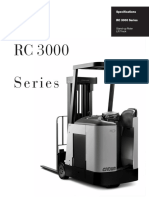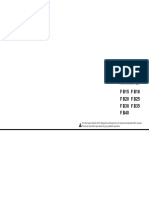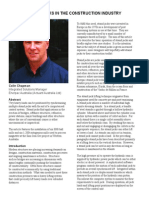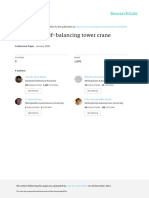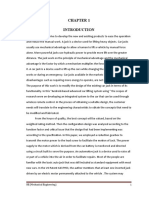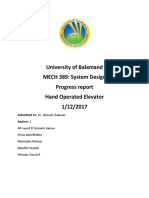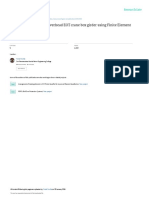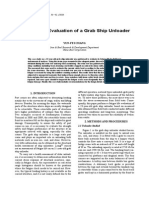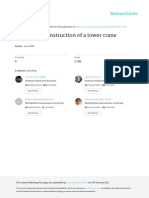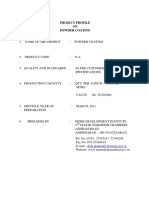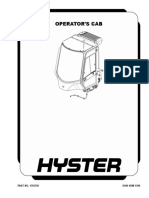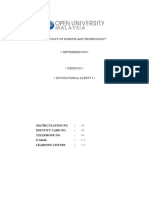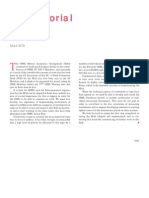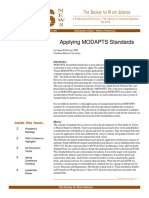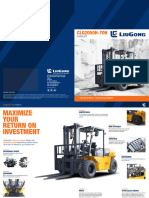Abstract:: Stress Based Topology Optimization of 30 Ton C Hook Using Finite Element Analysis
Abstract:: Stress Based Topology Optimization of 30 Ton C Hook Using Finite Element Analysis
Uploaded by
Aravind JCopyright:
Available Formats
Abstract:: Stress Based Topology Optimization of 30 Ton C Hook Using Finite Element Analysis
Abstract:: Stress Based Topology Optimization of 30 Ton C Hook Using Finite Element Analysis
Uploaded by
Aravind JOriginal Title
Copyright
Available Formats
Share this document
Did you find this document useful?
Is this content inappropriate?
Copyright:
Available Formats
Abstract:: Stress Based Topology Optimization of 30 Ton C Hook Using Finite Element Analysis
Abstract:: Stress Based Topology Optimization of 30 Ton C Hook Using Finite Element Analysis
Uploaded by
Aravind JCopyright:
Available Formats
STRESS BASED TOPOLOGY OPTIMIZATION OF 30 TON C HOOK
USING FINITE ELEMENT ANALYSIS
Abstract:
C-Hooks are the most used lifting equipment and involves heavy material for its
construction. Since the C-Clamps are made in bulk, any design optimization helps in
reducing the cost of the equipment. Due to the advances in the material technology and
finite element analysis, the design iterations can be carried out to find the best design
concept for the C-Clamp. Any discontinuity in the materials will cause catastrophic
failure and may damage the equipment to be handled.
In the present work, both theoretical concepts and finite element analysis is applied for
better design of C-Hook. All one dimensional, two dimensional and three dimensional
concepts are applied for better design of C-Hook. The requirement is the best product
development in the competitive industry, the effective utilization of Finite element
concepts along with theoretical concepts are used for optimization of the C-Hook.
Initially both theoretical and finite element calculations are done to check the correctness
of the results. Later finite element simulation is done for number of designs to find the
optimum design. Beam 3, and solid45 elements are used for finite element simulation.
The results are represented by individual members for checking the structural safety.
Since deformation and stress are the two major design parameters for structural safety, for
all the results these two values are represented. Further topology optimization is carried
out to reduce the weight of the structure.
DEPARTMENT OF MECHANICAL ENGINEERING, KSIT Page 4
STRESS BASED TOPOLOGY OPTIMIZATION OF 30 TON C HOOK
USING FINITE ELEMENT ANALYSIS
CONTENTS
PAGE NO
Certificate i
Declaration ii
Abstract iii
Acknowledgement iv
Chapter 1: Introduction 6
1.1 Lifting 6
1.2 Mechanical Lifting Equipment’s 6
1.3 Introduction to C-Hooks 9
Chapter 2: Literature review 15
Chapter 3: Problem Definition 20
Chapter 4: Methodology and Experimental Work 21
4.1 Design specifications 21
4.2 Design calculations 22
4.3 Geometry calculations 30
Chapter 5: Results and Discussions 32
5.1 Stresses developed 32
5.2 Considering the self weight of the problem 34
5.3 Stress in other components 43
5.4 Topology optimized structure 46
Chapter 6: Conclusion and Future scope 47
6.1 Conclusion 47
6.2 Future scope 48
References 49
DEPARTMENT OF MECHANICAL ENGINEERING, KSIT Page 5
STRESS BASED TOPOLOGY OPTIMIZATION OF 30 TON C HOOK
USING FINITE ELEMENT ANALYSIS
Chapter 1
Introduction
1.1 Lifting
A lifting operation is concerned with the lifting and lowering of a load. Heavy lifting is a
task in warehouses or a factory where large, heavy items have to be lifted and moved to
certain positions; this heavy lifting can became a problem without right equipment. High
quality equipment’s such as forklifts and pallet trucks can help to lift and move the load
but not enough to lift all types of loads.
1.2 Mechanical lifting equipment’s
1.2.1 Block and Tackle
A Block and Tackle is a system with more than two pulleys and a rope is threaded
between pulleys. Set of pulleys can be called as Block and the rope or cable used between
those pulleys can be said as Tackle.
These are used for lifting of heavy blocks. One pulley is attached to lifting load and
another will rotate over the rope. Fig1.2a Shows the Mechanism of lifting using block and
tackle equipment.
Fig. 1.2a Block and Tackle
DEPARTMENT OF MECHANICAL ENGINEERING, KSIT Page 6
STRESS BASED TOPOLOGY OPTIMIZATION OF 30 TON C HOOK
USING FINITE ELEMENT ANALYSIS
1.2.2 Forklift or Lift truck
It’s an industrial heavy truck used for lifting and moving heavy objects over the short
distance. The forklift was developed in the year 20th century itself by many companies.
Forklift is controlled with hydraulic valves or the electrical actuators, forklifts are
available in many varieties depending on the lifting capacity.
Fig.1.2b Forklift or Lift truck
1.2.3 Cranes
Cranes are the most used mechanical lifting devices. There are different types of cranes
which are being used based on the distance of lifting, height of lifting and even how often
to lift. For lifting any load cranes are connected with the crane hooks, hooks are
connected with ropes and chains with the help of crates, construction beams. Basic
function of crane hook is to lift loads and carry it to some other place.
Fig. 1.2.c lifting cranes
DEPARTMENT OF MECHANICAL ENGINEERING, KSIT Page 7
STRESS BASED TOPOLOGY OPTIMIZATION OF 30 TON C HOOK
USING FINITE ELEMENT ANALYSIS
1.2.4 Lifting eyebolt
An eye bolt is a bolt with a trap at one end. They are being used to firmly affix a securing
eye to a structure, so that ropes or cables will then be tied. There are four types of
eyebolts found and they are; regular eyebolt, screw eyebolt, machinery eyebolt and
shoulder eyebolt. All of them are used to rigging and they are manufactured by forged
process for getting greater strength.
Fig. 1.2.d Link Members
DEPARTMENT OF MECHANICAL ENGINEERING, KSIT Page 8
STRESS BASED TOPOLOGY OPTIMIZATION OF 30 TON C HOOK
USING FINITE ELEMENT ANALYSIS
1.3 Introduction to C Hooks
C Hooks are the instruments used to lift and carry heavy loads from one place to another
place. These are mainly used in construction areas, industries and at harbour to lift the
coils and the disc. A hook is an instrument with some length of material having curve
position, so that curve position is used to hold an object. One end of the hook is pointed
so that it can pierce into another material.
Hooks should not be loaded beyond the capacity of each; however it is loaded beyond the
limit during testing. Hooks having certain ductility is selected which undergo permanent
deformation before fracture.
Fig 1.3 C-Hook
Counterweight and the support saddle are welded to the main component and only the
bail region has to be constructed. Each C Hook is custom engineered according to the
requirements of the customers depending upon load carrying capacity, lifting areas etc.
DEPARTMENT OF MECHANICAL ENGINEERING, KSIT Page 9
STRESS BASED TOPOLOGY OPTIMIZATION OF 30 TON C HOOK
USING FINITE ELEMENT ANALYSIS
1.3.1 Types of C Hooks are
1. Motorized rotating C Hook
Fig 1.3a motorized rotating C Hook
The motorized rotating crane C Hook comes equipped with the motorized rotator
which is capable of rotating continuously with 360 degree rotation.
2. Paper Roll C Hook
Fig 1.3b Paper Roll C Hook
DEPARTMENT OF MECHANICAL ENGINEERING, KSIT Page 10
STRESS BASED TOPOLOGY OPTIMIZATION OF 30 TON C HOOK
USING FINITE ELEMENT ANALYSIS
This type of C Hook lifts the paper rolls by inserting roll at the lower end of the hook and
is then lifted.
3. Coil tripper C Hook
Fig 1.3c Coil Tripper C Hook
Used to move small palletized slit coils over a place and they are made up of high
strength steel with inside corner polished. It is available in a range of 500 to
10,000 pounds.
4. Slit Mult Lifter
Fig 1.3d Slit Mult Lifter
DEPARTMENT OF MECHANICAL ENGINEERING, KSIT Page 11
STRESS BASED TOPOLOGY OPTIMIZATION OF 30 TON C HOOK
USING FINITE ELEMENT ANALYSIS
It is designed for safe and fast placement of slit coil into a un-coiler mandrel. It
automatically adjusts for varying coil diameter.
1.3.2 Hooks service
Hooks service may be classified as three parts
a) Normal service: Operated less than 85% of the capacity
b) Heavy service : Operated between 85% to 100% of the capacity
c) Severe service: Operated at heavy service having abnormal operations (i.e. at high
temperatures, at corrosive environment etc.)
Hooks are inspected regularly for the safety region.
Initial inspection is done for the repaired hooks by a qualified field inspector to ensure the
proper working.
Daily inspection is done visually to inspect the hooks for the following deficiencies
a) Cracks, gouges and nicks
b) Deformation
c) Chemical damages
d) Damages due to heat
A designated person should examine deficiencies and determine whether they are safe are
not.
Frequent inspection is carried out personally by visual inspection at some intervals of
time
a) Normal service- carried out monthly
b) Heavy service- carried out weekly to monthly
c) Severe service
Periodic inspection shall be carried by a professional by performing a complete inspection
with following intervals
a) Normal service- yearly
b) Heavy service – semi annually
DEPARTMENT OF MECHANICAL ENGINEERING, KSIT Page 12
STRESS BASED TOPOLOGY OPTIMIZATION OF 30 TON C HOOK
USING FINITE ELEMENT ANALYSIS
c) Severe service- quarterly
Hooks shall be removed if found having the following conditions.
a) Deformation
b) Throat opening
c) Wear
d) Cracks
Hook users have to take care of these followings
Weight does not exceed the load rating of hook
Shock loading should be avoided
Prevent the point loading in the hook
Accidental failure in C Hooks
Due to hammerlock joints
Due to a crack in the linkage at hammerlock which is undetected during visual inspection
and the load test, during the unloading or loading of the coil it had failed in the figure
shown with the red mark in it.
Fig 1.3e Failure of C Hook Due to Crack in Hammerlock Joint
DEPARTMENT OF MECHANICAL ENGINEERING, KSIT Page 13
STRESS BASED TOPOLOGY OPTIMIZATION OF 30 TON C HOOK
USING FINITE ELEMENT ANALYSIS
1.3.4 General failure in C Hook
1. Pins failure
2. Inner lever failure
3. Finished coil damage
4. Excessive wear
1.3.5 Advantages of C Hook
Altitude operations, eliminate the risk of accident
Eliminate the hand injuries
Eliminate the handling of toxic materials
Reduce the heavy work
Increase the productivity, safety
1.3.6 Disadvantages of C Hook
Need to maintain counter weight
Only applicable to lift the coils
Proper positing of C Hook should be maintained.
DEPARTMENT OF MECHANICAL ENGINEERING, KSIT Page 14
STRESS BASED TOPOLOGY OPTIMIZATION OF 30 TON C HOOK
USING FINITE ELEMENT ANALYSIS
CHAPTER 2
LITERATURE REVIEW
1. Gopichand, R V S Lakshmi, Maheshakrishna [1] made an attempt to optimize the
crane hook. They analysed the hook by varying the design parameters like hook
area of cross section, material used for hook and radius of the hook. In order to
optimize the crane hook they used taguchi method while doing so they considered
three parameters and array is generated. Curved beam formula is used here; they
used different cross sectional area. The formula of stress is given by
Where,
M= Max. Bending Moment
Y=Distance between central axis to neutral axis
I= Moment of Inertia for different cross section
Finally combination of input parameters are determined using S N ratio plots.
They concluded that triangular cross section is the best combination with other
parameters.
2. NS Fellows Crop is a steel sheet specialized company having expert engineers.
They conducted experiment on C Hook used to lift the heavy coils in industrial
application. They analysed that strength of C Hook gradually decreases by means
of “Metal Fatigue”, when the loading is beyond the material strength C Hook
fails. C Hook is analysed using FEM method and the factor of safety is taken as 5.
Size of the C Hook is taken to be; thickness of body as 90mm, 12mm plates are
welded on the both sides of as reinforcement as shown in below fig.2a
DEPARTMENT OF MECHANICAL ENGINEERING, KSIT Page 15
STRESS BASED TOPOLOGY OPTIMIZATION OF 30 TON C HOOK
USING FINITE ELEMENT ANALYSIS
Fig.2a dimensions of a typical C-Hook
The stress generated in the C Hook is due to loading of 20Ton coil which is
195.55MPa at the upper and inner corners as shown in below fig.2b
Fig.2b stresses generated in a typical C-Hook
The deflection is more in inner radius of the model; they suggested that those
areas should be reinforced with flanges like H-beams.
3. ArutPranesh.K, Balasubramani and Joseph Leo [2] made an analysis on the crane
hook design considering design sections as their parameters; they said that failure
of crane hook depends on mainly three parameters Dimension, Material and
DEPARTMENT OF MECHANICAL ENGINEERING, KSIT Page 16
STRESS BASED TOPOLOGY OPTIMIZATION OF 30 TON C HOOK
USING FINITE ELEMENT ANALYSIS
Overload. They considered Dimension as their main variable; they selected the
three different dimensional cross section as Triangular, Square and Trapezoidal.
They created the model using PTC CREO software for modelling and ANSYS
14.5 workbench for solving the problem. By doing analysis on the different
sections they concluded that the trapezoidal section has the maximum yielding
capacity compared to other two sections.
4. Rashmi Uddanwadiker [3] did analysis on the crane hook for the failure of it, due
to large accumulation of stress which leads to failure, to study the stress pattern of
the crane hook in loaded condition, solid model of it is created using CMM and
CAD software and real pattern of stress concentration in 3D model of crane is
obtained. The stress on crane hook is analysed by Diffused light Polariscope
setup. She concluded that hook is manufactured by forging since it gives good
model over the casting, residual stresses is created in casting the material due to
non-uniform solidification, hence casted hooks cannot bear high tensile load.
The stress analysis shows that removal of material will increase the stress in
material which is not at all feasible. If area of inner side of hook at the portion of
maximum stress is widened then stress will get reduced. If the thickness is
increased by 3mm stress is reduced by 17%. Hence hook design can be modified
by increasing the inner thickness considerably.
5. Mahesh solanki, Antrikshbhatt, AnilkumarRathour and SmitThakkar [4] made an
analysis on Weight Optimization in Crane Hook, Crane hook mainly fails where
accumulation of large stresses occur. Model was created using the CATIA v5
software and they did the analysis using the ANSYS software. Stress
concentration factors has been considered, where stress concentration is less that
of the material to be removed. According to them stress concentration at nose
region is too less hence for weight optimization of hook they removed material
from nose region and they got a 7.08% of weight optimized hook structure. And
even they suggested that hook is modelled with I section and analysed to get better
result.
6. Amandeep Singh and VinodRohilla [5] conducted “Analysis on Optimization and
Fatigue analysis of a crane hook using finite element method”. They said that the
DEPARTMENT OF MECHANICAL ENGINEERING, KSIT Page 17
STRESS BASED TOPOLOGY OPTIMIZATION OF 30 TON C HOOK
USING FINITE ELEMENT ANALYSIS
failure occurring in the crane hook is due to the cyclic loading and unloading
conditions. In this they created model using solid works, used ANSYS as they
used ANSYS Workbench and nCode Design life. They conducted test for 30Tons
loading.
They obtained 24 results; depending on the weight optimized they selected 3 best
results, as the weight of the hook is reduced for the same load. They conducted
Fatigue analysis on the 3 best results using ansysnCodeDesignlife. As a result one
result was selected on the basis of maximum fatigue life and compared with actual
one. They found that weight of obtained result is reduced by 15.861Kg compared
to the actual hook model. The weight of the hook is reduced by 22.03% which is
accepted as optimized result.
7. Tejas.P.Jani [6] has made analysis on reduction of weight of crane hook capacity
of 8Tons load and alternative cross section, they had selected dimension as basic
parameter for optimization they have created model in CREO 2.0 and analysed in
ANSYS 15.0 workbench. On the basis of previous experimental trapezoidal
section holds good for crane hook they modified standard trapezoidal and then
compared with Trapezoidal, circular and Triangular sections.
Modified design hook is reduced by 2.483Kg compared to standard hook, they
optimized the standard design by varying cross sections and best section is
selected in which stress is increased to 6.76% which can be accepted when weight
is deducted by 18% which s treated as optimized result.
8. S.S.Deshpande [7] did the analysis on a plate having a circular hole, plate having
circular hole is subjected to uniform stress and they said that stretching of hole is
due to the external load application this was studied using finite element analysis.
They assumed some conditions that the initial stretching of the hole is due to
external load applied to opposite side of hole and they assumed as hole contains in
thick plate goes parallel.
They analysed that lots of variation occurred in result is due to various mesh size.
The FEA result is significantly affected by meshing size. They concluded that at
stress concentration region mesh size should be finer to get a better result.
9. D. Bharadwaj [8] studied the stress analysis of curved beam, in this paper they
said that in the curved beam due to application of bending moment, tensile stress
DEPARTMENT OF MECHANICAL ENGINEERING, KSIT Page 18
STRESS BASED TOPOLOGY OPTIMIZATION OF 30 TON C HOOK
USING FINITE ELEMENT ANALYSIS
is found in one section of the beam and compression in other section. They said
that analytical computation for determining these stresses are too complex, so they
calculated bending stress and deflection of the curved beam using ANSYS
software and validated using standard curved beams formulae. They concluded
that stress value found to be maximum when a circular arc is subjected to bending
load and they even said they when the same load conditions are applied to a semi-
circular beam they found that maximum stress values are developed than the other
case. The procedure adopted in this paper for modelling different types of circular
beam is helpful to test stress values of various shapes of curved beam.
DEPARTMENT OF MECHANICAL ENGINEERING, KSIT Page 19
STRESS BASED TOPOLOGY OPTIMIZATION OF 30 TON C HOOK
USING FINITE ELEMENT ANALYSIS
CHAPTER 3
PROBLEM DEFINITION
Topology Optimization of the C-Hook using Finite element analysis with the help of
theoretical design concepts is the main definition of the problem.
Theoretical Design of critical sections for the given load data
Three dimensional modelling and analysis
Methods of reduction of mass through topology optimization
Need for Problem: C-clamps are the most used lifting equipment for lifting the heavy
loads. The design is very simple when compared to other mechanisms. It is mainly made
of a ‘C’ frame when compared to complex mechanisms of multiple scissors. Simple
design of C-frame is enough for the problem. This C-frame design is mainly made of
beam concept along with a hinge point for lifting. A crane hook is used for lifting of the
equipment from either overhead conveyor or JCB etc. But this equipment has a drawback
of counter weight requirement along with sudden lift in case a sudden unloading of the
equipment. So proper precautions need to be considered while designing the structure.
Topology optimization is the process of optimizing the design parameters with in the
design space with the main aim of redistributing the stresses along with weight reduction.
An example for topology optimization is as shown in the below fig.3a in which the
structure is optimized by removing the areas where low stress is acting.
Fig.3a typical topology optimized structure
DEPARTMENT OF MECHANICAL ENGINEERING, KSIT Page 20
STRESS BASED TOPOLOGY OPTIMIZATION OF 30 TON C HOOK
USING FINITE ELEMENT ANALYSIS
CHAPTER 4
METHODOLOGY AND EXPERIMENTAL WORK
Literature on C-Hook designs and its probable problems
Theoretical calculations for minimum section requirements along with finite
element validation
Geometrical modelling and Analysis for structural safety
Material optimisation through topology optimisation
Comparison of structural strength and weight of initial and optimized design
Report generation.
4.1 Design Specifications:
Coil Diameter to be lifted: 2.5 meter
Length of the Coil: 2 meter
Total Coil Weight=30 tons
Minimum dimensions required for the C-Frame
Length of the C-Frame: 2.3 meter (Minimum gap of 300mm at the edge of C-frame)
Minimum height of the C-Frame: 1.5m
Material properties table:
Material Elastic Poison’s Density Yield Allowable
Specification Modulus ratio Stress Stress(Mpa)
(Mpa)
Mild Steel 200Gpa 0.3 7850kg/m3 250 100
Table4.1: Material Specification
DEPARTMENT OF MECHANICAL ENGINEERING, KSIT Page 21
STRESS BASED TOPOLOGY OPTIMIZATION OF 30 TON C HOOK
USING FINITE ELEMENT ANALYSIS
4.2 Design Calculations:
A line Segment approach for design calculations is carried out. The following diagram
shows a ‘C-frame’ model for the design calculations. Hinge point is considered 1/4
distance from the right end.
Fig.4.2a Dimensional Representation of the Problem
The Fig.4.2a represents line representation of the C-Hook problem. All the dimensions of
individual arms or segments are shown in the figure. Maximum length is around 2300mm
and these dimensions will be altered based on the sectional requirements of the problem.
Bending moment and shear force calculations will be carried out to find the sectional
requirements.
DEPARTMENT OF MECHANICAL ENGINEERING, KSIT Page 22
STRESS BASED TOPOLOGY OPTIMIZATION OF 30 TON C HOOK
USING FINITE ELEMENT ANALYSIS
Fig.4.2b Segment Representation
The Fig.4.2b shows segment representation of the problem. The shear force and bending
moments are calculated as follows.
Shear Force and Bending Moment Calculations:
Total load: 30 tons=30000kgs or 300000N or 300KN
If 300KN is applied on a length of 2300mm, the uniformly distributed load value is
w=300000/2300=130.43N/mm
For analysing the segment, each segment is assumed to be fixed. The following boundary
conditions are applied.
DEPARTMENT OF MECHANICAL ENGINEERING, KSIT Page 23
STRESS BASED TOPOLOGY OPTIMIZATION OF 30 TON C HOOK
USING FINITE ELEMENT ANALYSIS
Fig.4.2c Boundary Conditions of the problem
Here the load is converted to uniformly distributed load and the load is applied with
hinged boundary conditions.
Bending Moment calculations for segment 1:
Assuming the left end is constrained, maximum moment created by UDL for cantilever
configuration is
M1=wL2/2=-130.43*23002/2=-344987350N-mm (Here negative sign represents
clockwise moment)
The value is approximated to 345e6N-mm.
Shear Force at segment 1=wL=130.43*2300=300000N
DEPARTMENT OF MECHANICAL ENGINEERING, KSIT Page 24
STRESS BASED TOPOLOGY OPTIMIZATION OF 30 TON C HOOK
USING FINITE ELEMENT ANALYSIS
Fig.4.2d Shear Force Diagram (Maximum Shear Force is 300000N)
Finite element validation is carried out using Ansys beam3 element for shear force and
bending moment estimation. The geometry is analysed by creating the line models for the
given dimensions and later the load is applied on the segment 1.
DEPARTMENT OF MECHANICAL ENGINEERING, KSIT Page 25
STRESS BASED TOPOLOGY OPTIMIZATION OF 30 TON C HOOK
USING FINITE ELEMENT ANALYSIS
Fig.4.2e Bending Moment Diagram (Maximum Moment :(( 345e6N-mm))
Fig.4.2f listing of the bending Moments from Ansys
DEPARTMENT OF MECHANICAL ENGINEERING, KSIT Page 26
STRESS BASED TOPOLOGY OPTIMIZATION OF 30 TON C HOOK
USING FINITE ELEMENT ANALYSIS
Ansys has an option to list all the values by list nodal solution option. With the option,
obtained moment values at each element are shown. Similarly other segments are also
calculated.
For segment 2
Since the shear force on the segment 2 is acting as an axial load for the second
configuration, no shear force diagram can be represented. Similarly same moment which
is obtained for the previous segment will be transferred to the second segment also. So the
results for second segment is
Fig.4.2g Shear Force in the Second Segment (Almost Zero Value)
DEPARTMENT OF MECHANICAL ENGINEERING, KSIT Page 27
STRESS BASED TOPOLOGY OPTIMIZATION OF 30 TON C HOOK
USING FINITE ELEMENT ANALYSIS
Fig.4.2h Bending Moment in the Second Segment (Maximum Moment: 345e6N-mm)
Fig.4.2i Shear Force Diagram on Segment 3(Maximum Shear Force: 300000N)
DEPARTMENT OF MECHANICAL ENGINEERING, KSIT Page 28
STRESS BASED TOPOLOGY OPTIMIZATION OF 30 TON C HOOK
USING FINITE ELEMENT ANALYSIS
Fig.4.2j Bending Moment Calculation for Segment 3(Maximum Moment =345e6N-mm)
Fig.4.2k Shear Force Diagram for the Entire Assembly (Maximum Shear Force:
300000N)
DEPARTMENT OF MECHANICAL ENGINEERING, KSIT Page 29
STRESS BASED TOPOLOGY OPTIMIZATION OF 30 TON C HOOK
USING FINITE ELEMENT ANALYSIS
Fig.4.2L Bending Moment Diagram for the Assembly (Maximum Moment 345e6N-mm)
4.3 Geometry Calculations
The geometrical sections of the problem are calculated based on bending moment and
shear stress estimates. From the shear force and moment calculations we have,
Maximum Shear Force: F=300000N
Maximum Bending Moment: M=345e6N-mm
Minimum Cross section required based on shear Force A=300000/σd
Here σd is the design stress.
Based on factor of safety 2.5, Design Stress σd=250/2.5=100N/mm2.
A=300000/100=3000mm2.
DEPARTMENT OF MECHANICAL ENGINEERING, KSIT Page 30
STRESS BASED TOPOLOGY OPTIMIZATION OF 30 TON C HOOK
USING FINITE ELEMENT ANALYSIS
Minimum section required based on Bending Moment:
Mmax=345e6N-mm
Assuming a rectangular section of the beam
From basic mechanics of material formulations
σb= 6Mmax/(bh2)
Here b=width of the beam
h=depth of the beam
Due to 2 unknown variables width can be assumed.
Width of the beam b=120mm
h2=6*345e6/(120* σb)=172500mm2
h=415mm.
Minimum section required based on bending moment calculation is 120X415mm to take
the loads. But, since the maximum moments takes places at the end, the beam shape can
be optimised based on bending moment diagrams.
DEPARTMENT OF MECHANICAL ENGINEERING, KSIT Page 31
STRESS BASED TOPOLOGY OPTIMIZATION OF 30 TON C HOOK
USING FINITE ELEMENT ANALYSIS
CHAPTER 5
RESULTS AND DISCUSSIONS
5.1 Stresses developed: Analysis Results for Beam of 120mm
width and 415mm height
Fig.5.1a Stress due to Bending Loads and Shear Loads
The fig.5.1a shows maximum stress of 107.323Mpa in red coloured regions. This stress
is higher than the allowable stress of the material and so the sections considered is not
sufficient to take the loads. So iterations are carried out until the structural safety is
obtained.
DEPARTMENT OF MECHANICAL ENGINEERING, KSIT Page 32
STRESS BASED TOPOLOGY OPTIMIZATION OF 30 TON C HOOK
USING FINITE ELEMENT ANALYSIS
Fig.5.1b From the iterations final Stress (Dimensions width: 120mm, height: 428mm)
The figure 3.14shows structural safety for the design dimensions of 120mm width and
428mm height for the beam. The segment 2 has maximum stress compared to the other
regions. Since it is a heavy structure, self weight also plays very important role in the
structural safety. So analysis is carried out further with self weight consideration. So
further input of acceleration due to gravity and mass density are required as input to find
the self weight solution.
DEPARTMENT OF MECHANICAL ENGINEERING, KSIT Page 33
STRESS BASED TOPOLOGY OPTIMIZATION OF 30 TON C HOOK
USING FINITE ELEMENT ANALYSIS
5.2 Considering the self weight of the problem
Fig.5.2a Deflection due to Self weight (Maximum deflection: 0.3mm)
Fig.5.2b Vonmises Stress due to Self Weight (Maximum Stress: 5.79Mpa)
DEPARTMENT OF MECHANICAL ENGINEERING, KSIT Page 34
STRESS BASED TOPOLOGY OPTIMIZATION OF 30 TON C HOOK
USING FINITE ELEMENT ANALYSIS
Fig.5.2c self weight of the C-frame
The figure5.2c shows self weight of the C-frame. The results shows total weight of
considered beam which is around 23973N or 2.3 tons.
By iterating to the safety of the structure, following dimensions are considered.
Final Dimensions of the problem:
Height of the beam: 800mm (Due to removal of the material for hinging and factor of
safety of the loads).
Width of the beam: 120mm
Cross sectional area A=1e5mm2
Moment of Inertia of the problem: 0.54e10mm4.
Weight of the structure W=52721N or 5.3 Tons
Since the present work is going by conventional design, the following figures shows
dimensions considered based on conventional drawings for the C-clamp.
DEPARTMENT OF MECHANICAL ENGINEERING, KSIT Page 35
STRESS BASED TOPOLOGY OPTIMIZATION OF 30 TON C HOOK
USING FINITE ELEMENT ANALYSIS
Fig.5.2d Drafting Details of C-Frame
The fig.5.2d shows dimensions considered for the C-Hook after modifying the
dimensions considering the standard drawing of old C-Frames. The sketch is represented
in the Solid Works which is a three dimensional modelling software. In the sketcher the
object is built to the required dimensions. Fillets are specified for reducing the stress in
the member. Even the position of the hinge is changed to reduce the counter weight
requirement in the problem.
DEPARTMENT OF MECHANICAL ENGINEERING, KSIT Page 36
STRESS BASED TOPOLOGY OPTIMIZATION OF 30 TON C HOOK
USING FINITE ELEMENT ANALYSIS
Fig.5.2e Geometrical Model
• The fig.5.2e shows modelled C-Hook with all its major components. The bottom
frame is provided with a cover plate for easier lifting of the coil without any
scratches along with uniform distribution of load. At the curve regions, curved
ribs are used for strengthen of the plate. Initially all the member are represented
in the sketcher and later converted to three dimensional models by part modelling.
A back plate was installed to alleviate the damage done to the coil wall when the
leg portion of the C-Hook hit it. This striking of the coil wall occurs almost
always, and especially when picking up coils of maximum width. C-Hooks are
designed so that the coil wall of a maximum width will be approximately one inch
away from the leg edge when lifting and transporting it. Ideally, a crane operator
from a hundred feet or more away inserts the lifting leg of the C-Hook into the eye
of the coil without the leading edge (or “nose”) ever touching the coil wall, and
then stop the insertion process when the coil wall is just a half inch or so from
striking the back plate. The probability of lifting the coil in this manner without
damage is extremely low.
DEPARTMENT OF MECHANICAL ENGINEERING, KSIT Page 37
STRESS BASED TOPOLOGY OPTIMIZATION OF 30 TON C HOOK
USING FINITE ELEMENT ANALYSIS
Fig5.2f Mesh Model
The fig.5.2f shows meshed view of the problem. The members are separately meshing
and connectivity is maintained after surface interface action is activated in the Hypermesh
software. Total of 85872 elements are used with tetrahedral type element. In the Ansys
Solid45 element is attached for solving the problem. Mesh is an important step in
converting geometrical problem to finite element problem. Once mesh is done, boundary
conditions can be applied for executing the problem.
DEPARTMENT OF MECHANICAL ENGINEERING, KSIT Page 38
STRESS BASED TOPOLOGY OPTIMIZATION OF 30 TON C HOOK
USING FINITE ELEMENT ANALYSIS
Fig.5.2g: Boundary conditions for the C-Hook
The figure 5.2g shows boundary conditions for the C-hook problem. Bottom arm is
applied with a uniformly distributed load of 300KN and top arm is applied with a
distributed load of 5 tons as the counter weight. The Crane hook region is constrained in
all the translational directions.
DEPARTMENT OF MECHANICAL ENGINEERING, KSIT Page 39
STRESS BASED TOPOLOGY OPTIMIZATION OF 30 TON C HOOK
USING FINITE ELEMENT ANALYSIS
Fig.5.2h Displacement plot
The fig.5.2h shows maximum displacement of 3.55mm. The location of maximum
displacement is shown in the figure by red colour region. This deflection is less than the
allowable deflection and so the structure is safe for the given loading.
DEPARTMENT OF MECHANICAL ENGINEERING, KSIT Page 40
STRESS BASED TOPOLOGY OPTIMIZATION OF 30 TON C HOOK
USING FINITE ELEMENT ANALYSIS
Fig.5.2i vonmises Stress Plot
The figure 5.2i shows developed vonmises stress in the problem. Maximum stress
development is 144Mpa which is more than the allowable stress of 100Mpa. But this
higher stress is localized and will be distributed locally and will not affect the problem.
DEPARTMENT OF MECHANICAL ENGINEERING, KSIT Page 41
STRESS BASED TOPOLOGY OPTIMIZATION OF 30 TON C HOOK
USING FINITE ELEMENT ANALYSIS
Fig.5.2j Stress region where low grade material can be used (Blue Colour Region)
The fig.5.2j shows minimum stresses exist in the central regions. Even the theory of
beams also says maximum stress is concentrated in the outer boundaries and less stress or
zero stress at the neutral region. The blue colour region shows stress level of zero to 12.2
Mpa. So this region can be improved to reduce the weight. The individual component
results are as follows. Individual component results are as follows.
DEPARTMENT OF MECHANICAL ENGINEERING, KSIT Page 42
STRESS BASED TOPOLOGY OPTIMIZATION OF 30 TON C HOOK
USING FINITE ELEMENT ANALYSIS
5.3 Stress in other components
Fig.5.3a Stress in the Cover Plate (Maximum Stress: 18.12Mpa)
Fig.5.3b Stress in the Pin (Maximum Stress: 3.32Mpa)
DEPARTMENT OF MECHANICAL ENGINEERING, KSIT Page 43
STRESS BASED TOPOLOGY OPTIMIZATION OF 30 TON C HOOK
USING FINITE ELEMENT ANALYSIS
Fi.5.3c Stress in the Link Plate
Fig.5.3d Vonmises stress in the upper rib plate
DEPARTMENT OF MECHANICAL ENGINEERING, KSIT Page 44
STRESS BASED TOPOLOGY OPTIMIZATION OF 30 TON C HOOK
USING FINITE ELEMENT ANALYSIS
Fig5.3e Vonmises stress in the bottom rib plate (Maximum Stress: 26.65 Mpa)
The estimations for weight shows that the total weight of the Structure as 11973kgs
Fig.5.3f Members with low stress (Below 18 Mpa)
DEPARTMENT OF MECHANICAL ENGINEERING, KSIT Page 45
STRESS BASED TOPOLOGY OPTIMIZATION OF 30 TON C HOOK
USING FINITE ELEMENT ANALYSIS
5.4 Topology Optimized structure
Fig.5.4 topology optimised structure
The fig.5.4 shows optimised structure after removal of the material. By Element Birth and
Death feature, the low stress elements can be killed and only live elements can be
displayed using Ansys post processor. Final weight: 8243kgs and Overall weight
reduction in the problem is 31.6%.
DEPARTMENT OF MECHANICAL ENGINEERING, KSIT Page 46
STRESS BASED TOPOLOGY OPTIMIZATION OF 30 TON C HOOK
USING FINITE ELEMENT ANALYSIS
CHAPTER 6
CONCLUSIONS AND FUTURE SCOPE
6.1 CONCLUSIONS
A C-Hook design was carried out for weight reduction using theoretical concepts and
finite element analysis. The analysis summary is as follows.
Initially theoretical calculations were carried out for the given design
requirements. Using free body diagram, initially bending moments and shear
force diagrams are represented for the problem. Both theoretical and finite
element calculations were compared and results found matching and so finite
element calculations are carried out further.
Once the moments and shear forces are calculated, the sectional dimensions were
calculated for structural safety. Due to the dimensional calculation, the design
dimensions were altered and further iterations were carried out for structural
safety under external loading and self weight. The final dimensions were
concluded with width requirement of 120mm and height of the beam requirement
of 800mm.
Further a three dimensional model was considered based on conventional
rectangular representation with the calculated values. The geometry was built
using Solid Edge software and meshed with Hypermesh. The results shows safety
of the structure for the given structural loads (external load 300000N, counter
weight of 5 tons and self weight).
Topology optimisation was carried out to reduce the weight. The results show
weight reduction from 11973kgs to 8243kgs. So a weight reduction of 31.6% is
observed in the problem.
DEPARTMENT OF MECHANICAL ENGINEERING, KSIT Page 47
STRESS BASED TOPOLOGY OPTIMIZATION OF 30 TON C HOOK
USING FINITE ELEMENT ANALYSIS
6.2 FUTURE SCOPE
Composite material usage can be checked
Shape optimisation can be carried out
Transient response analysis can be carried out
Dynamic response can be calculated
Full assembly with coil in the position can be carried out
Possible thermal effects can be carried out
DEPARTMENT OF MECHANICAL ENGINEERING, KSIT Page 48
STRESS BASED TOPOLOGY OPTIMIZATION OF 30 TON C HOOK
USING FINITE ELEMENT ANALYSIS
REFERENCES
1. Arutpranesh.k,Balasubramani,Joseph Leo “A Structural analysis of crane hook”,
International jouranal of emerging technology in computer science and
electronics, IJETCSE, Vol 12, ISSN: 0976-1353, June 2015.
2. Rashmi Uddanwadiker,“Design of crane hook of composite materials and stress
analysis using ANSYS workbench”, IJRASET, ISSN: 2321-9653, Vol 3, July
2015.
3. Mahesh Solanki, Antrikshbhatt, Anil Kumar Rathour, smit.Thakkar “Design and
analysis of crane hook”, IJIERE, ISSN: 2394-3343, Vol 4, April 2016.
4. Tejas.P.Jain, “Review of finite element analysis of crane hook”, IJRAT E-ISSN:
2321-9637, July 2016.
5. D.Bharadwaj, “Analysis of Stress distribution in a Curved structure using
Photoelastic and Finite element Method”, IAEME, ISSN: 0976-6340, VOL 6,
Issue 7, Ver III, 2017.
6. Li Rong-hao, Yang Jue,” Optimisation Design of the Lifting Mechanism of the
Electric Wheel Mining Truck”, JCPRCS, ISSN: 0975-7384, University of
Science and Technology, Beijing. 2017.
7. Sam Hutcheson,” Design and Construction of a portable Gantry Hoist”, California
Polytechnic State University, 2018.
8. A Sloboda, P. Honamandi,” Generalized Elasticity Method for Curved Beam
Stress Analysis: Analytical and Numerical Comparisons for a Lifting Hook”,
Mechanics based Design of Structures and Machines, Vol 35, issue 3, 2018.
DEPARTMENT OF MECHANICAL ENGINEERING, KSIT Page 49
You might also like
- SOP Container Loading and UnloadingDocument7 pagesSOP Container Loading and Unloadingakmalizzairudin100% (3)
- Crown SP3000 ServiceDocument805 pagesCrown SP3000 ServiceAaron Diaz Barrientos100% (3)
- Crown RC3000Document6 pagesCrown RC3000Saul Rosales100% (1)
- Safety Officer Saudi Aramco Questions and Answers PDF - HSE OFFICER Saudi Aramco Questions and Answers PDFDocument23 pagesSafety Officer Saudi Aramco Questions and Answers PDF - HSE OFFICER Saudi Aramco Questions and Answers PDFQasim Awan100% (8)
- Combilift 20whe ServicioDocument116 pagesCombilift 20whe ServicioEdinson Floriano100% (1)
- 360 Degree Conveyor Belt PDFDocument4 pages360 Degree Conveyor Belt PDFUpendra BingundiNo ratings yet
- Methodology of Static Pile Load TestDocument33 pagesMethodology of Static Pile Load Testraju_420034520100% (2)
- Crane Girder Beam Design - ExampleDocument6 pagesCrane Girder Beam Design - Exampledinesh100% (5)
- FB15-FB40 Manual de Operaciones Montacargas ElectricoDocument120 pagesFB15-FB40 Manual de Operaciones Montacargas ElectricoServicio TecnicoNo ratings yet
- My Summer Internship ReportDocument72 pagesMy Summer Internship ReportJones Mathew75% (8)
- 3 D Modelling and Finite Element Analysis of Eot CraneDocument4 pages3 D Modelling and Finite Element Analysis of Eot CraneKenneth ShumNo ratings yet
- Design and Analysis of Structural Members of The Jib CraneDocument4 pagesDesign and Analysis of Structural Members of The Jib CraneInternational Journal of Innovative Science and Research TechnologyNo ratings yet
- Cable Stayed BackwardDocument69 pagesCable Stayed BackwardIonut FalcescuNo ratings yet
- 3-D Modelling AND Finite Element Analysis OF EOT Crane: Abhinay Suratkar, Vishal ShuklaDocument4 pages3-D Modelling AND Finite Element Analysis OF EOT Crane: Abhinay Suratkar, Vishal ShuklaNaresh DesaiNo ratings yet
- JETIR1902975Document6 pagesJETIR1902975simpi.kunalNo ratings yet
- 16I26 IJAET0826483 v8 Iss2 pp150 162Document13 pages16I26 IJAET0826483 v8 Iss2 pp150 162Zubair AhmedNo ratings yet
- Irjet V3i7146 PDFDocument6 pagesIrjet V3i7146 PDFatulnarkhede2002No ratings yet
- EXPERIMENT 3: Deflection of Simply Supported Beam and Cantilever Beam Cantilever BeamDocument7 pagesEXPERIMENT 3: Deflection of Simply Supported Beam and Cantilever Beam Cantilever BeamZol Has100% (1)
- GargAamod GantryGirdersinIndiaDocument6 pagesGargAamod GantryGirdersinIndiaTinu JainNo ratings yet
- Design and Analysis of Fixture For Heavy Shell TiltingDocument5 pagesDesign and Analysis of Fixture For Heavy Shell Tiltinggkdora574No ratings yet
- Design Consideration of Adjustable Height and Radial Belt Conveyor SystemDocument6 pagesDesign Consideration of Adjustable Height and Radial Belt Conveyor SystemseventhsensegroupNo ratings yet
- PILE LOAD TEST REPORT BR 22 InitialDocument33 pagesPILE LOAD TEST REPORT BR 22 InitialMohabbat100% (1)
- 2 Cable Stayed Backward PDFDocument69 pages2 Cable Stayed Backward PDFHafiz DoyoxNo ratings yet
- Group 4presention 4Document48 pagesGroup 4presention 4yohannes tubeNo ratings yet
- Design and Analysis With Numerical Method of Gantry Crane Main BeamDocument7 pagesDesign and Analysis With Numerical Method of Gantry Crane Main BeamdbaNo ratings yet
- LEEA Entry Test PaperDocument12 pagesLEEA Entry Test PaperMohamed DabyNo ratings yet
- E02 - Bridge CraneDocument13 pagesE02 - Bridge CraneLenin Pardo SalazarNo ratings yet
- 07 Strand Jack Sedition 92834Document7 pages07 Strand Jack Sedition 92834vigobboNo ratings yet
- Design Procedure For Crane Runway Girders - bk105 PDFDocument7 pagesDesign Procedure For Crane Runway Girders - bk105 PDFFWICIPNo ratings yet
- IJRPR14431Document8 pagesIJRPR14431Flo WerNo ratings yet
- Design and Fabrication of Remote Operated Scissor JackDocument4 pagesDesign and Fabrication of Remote Operated Scissor JacksanthoshdonNo ratings yet
- Jian Lei Ren, Ji Shun Li, Fang Yang and Jie ChenDocument5 pagesJian Lei Ren, Ji Shun Li, Fang Yang and Jie Chenjeremytoh89No ratings yet
- Economic Design of EOT Crane (FINAL)Document29 pagesEconomic Design of EOT Crane (FINAL)ansh1983No ratings yet
- Self Balancing Tower CraneDocument8 pagesSelf Balancing Tower CranevikhnuNo ratings yet
- Version Final PublicadaDocument13 pagesVersion Final Publicadaelarab29No ratings yet
- A4-Design SumanPathak 01 FullpartDocument13 pagesA4-Design SumanPathak 01 Fullpartperezleon.rdNo ratings yet
- Design and Analysis With Numerical Method of Gantry Crane Main BeamDocument7 pagesDesign and Analysis With Numerical Method of Gantry Crane Main BeamSOUFIANE ADIBNo ratings yet
- Tower Crane DiscussionsDocument18 pagesTower Crane DiscussionsGelbert SilotNo ratings yet
- A5 WedgeSplittingTestDocument9 pagesA5 WedgeSplittingTestPrayush RajbhandariNo ratings yet
- Design Optimization of EOT Crane GirderDocument5 pagesDesign Optimization of EOT Crane Girdermech_abhiNo ratings yet
- An Anti-Collision System For Tower Cranes ConsiderDocument7 pagesAn Anti-Collision System For Tower Cranes ConsiderWin MinmaungNo ratings yet
- Mechanically Advanced Scissor JackDocument41 pagesMechanically Advanced Scissor JackAmit VishwakarmaNo ratings yet
- 00 Practice 2 Bridge CraneDocument14 pages00 Practice 2 Bridge CraneMarco NeveNo ratings yet
- Perners MolnarDocument16 pagesPerners Molnarvtt48No ratings yet
- 29.design and Analysis With Finite Element Method of Jib CraneDocument4 pages29.design and Analysis With Finite Element Method of Jib Cranesuresh_501No ratings yet
- Method SatementDocument31 pagesMethod SatementAhmed Nasser ElaminNo ratings yet
- 4 Thesis DATA - New3Document37 pages4 Thesis DATA - New3Kailas DNo ratings yet
- CDROM - EPMESC - Regular Sessions - R-72 - WangZBDocument5 pagesCDROM - EPMESC - Regular Sessions - R-72 - WangZBRizqa RuvianaNo ratings yet
- Design and Static Analysis of I Section Boom For Rotary Jib Crane IJERTV3IS080816Document4 pagesDesign and Static Analysis of I Section Boom For Rotary Jib Crane IJERTV3IS080816Evodius Rweyemamu100% (1)
- 4 Thesis DATA - NewDocument18 pages4 Thesis DATA - NewKailas DNo ratings yet
- T SectionDocument7 pagesT SectionMilan MaticNo ratings yet
- Development and Application of Lightweight CoringDocument7 pagesDevelopment and Application of Lightweight CoringKevin Kangwa MwilaNo ratings yet
- Final Paper Automatic Sortingmachineusing Conveyor Belt 170386Document5 pagesFinal Paper Automatic Sortingmachineusing Conveyor Belt 170386ఉదయ్ ప్రభూNo ratings yet
- لقطة شاشة 2022-08-10 في 2.29.19 مDocument143 pagesلقطة شاشة 2022-08-10 في 2.29.19 م66svd6hm9bNo ratings yet
- Irjet Design Analyasis and OptimizationDocument5 pagesIrjet Design Analyasis and OptimizationMustafa MazinNo ratings yet
- Hand Operated Elevator ReportDocument30 pagesHand Operated Elevator ReportJerjy ElsoussNo ratings yet
- Design and Analysis of Lifting Carriage of 4T Overhead Stacker CraneDocument5 pagesDesign and Analysis of Lifting Carriage of 4T Overhead Stacker CraneInternational Journal of Innovative Science and Research TechnologyNo ratings yet
- Design Optimization of Overhead EOT Crane Box Girder Using Finite Element MethodDocument6 pagesDesign Optimization of Overhead EOT Crane Box Girder Using Finite Element MethodAnantha RamanNo ratings yet
- Analysis of Main Beam of Bridge Crane Based On ANSYSDocument5 pagesAnalysis of Main Beam of Bridge Crane Based On ANSYSInternational Journal of Research in Engineering and ScienceNo ratings yet
- DDR Design Report 1-36Document36 pagesDDR Design Report 1-36api-544543693No ratings yet
- Fatigue Life Evaluation of A Grab Ship Unloader-Macara PDFDocument6 pagesFatigue Life Evaluation of A Grab Ship Unloader-Macara PDFflorinelvvNo ratings yet
- Design and Construction of A Tower Crane: June 2009Document6 pagesDesign and Construction of A Tower Crane: June 2009Ashwin B S RaoNo ratings yet
- MD2 149Document6 pagesMD2 149Vinay S 007No ratings yet
- CompositeMegaColumns Full Report PDFDocument275 pagesCompositeMegaColumns Full Report PDFWasin Waiyasusri100% (1)
- g7 3j04 Lab - FinalDocument46 pagesg7 3j04 Lab - Finalyliu8877100% (1)
- Handbook On Oil Cooling Blower (OCB) of Three Phase Eelectric Locomotive-May 2018Document55 pagesHandbook On Oil Cooling Blower (OCB) of Three Phase Eelectric Locomotive-May 2018Aravind J100% (1)
- Ipo RHP Prince PDFDocument506 pagesIpo RHP Prince PDFAravind JNo ratings yet
- Project Profile ON Powder Coating: Dcdi-Ahmbad@dcmsme - Gov.inDocument9 pagesProject Profile ON Powder Coating: Dcdi-Ahmbad@dcmsme - Gov.inAravind JNo ratings yet
- GrabtongDocument20 pagesGrabtongAravind J100% (1)
- Stress Based Topology Optimization of 30 Ton C Hook Using FEM.Document48 pagesStress Based Topology Optimization of 30 Ton C Hook Using FEM.Aravind J100% (1)
- Manual Oper. y Manten. 1TN - 3,5TN R Series (Comb. Interna) Suplemento PDFDocument43 pagesManual Oper. y Manten. 1TN - 3,5TN R Series (Comb. Interna) Suplemento PDFRicardo BilbaoNo ratings yet
- βιβλιοL12L L12LPDocument61 pagesβιβλιοL12L L12LPCreta KlarkNo ratings yet
- Haseen Cveast LankaDocument3 pagesHaseen Cveast LankaNafraz MohamedNo ratings yet
- Forklift Operators Daily ChecklistDocument1 pageForklift Operators Daily ChecklistLai Mei EeNo ratings yet
- Axxessor SSV10 Store Support VehicleDocument12 pagesAxxessor SSV10 Store Support VehicleForklift Systems IncorporatedNo ratings yet
- 0100SRM1390 (12 2018) Us en PDFDocument96 pages0100SRM1390 (12 2018) Us en PDFJIM CAMPBELLNo ratings yet
- Catalogo Donghua Leaf Lift ChainDocument103 pagesCatalogo Donghua Leaf Lift ChainHumberto Augusto de BorbaNo ratings yet
- V30ZMUDocument26 pagesV30ZMUmanuelsaenzNo ratings yet
- XBOS 3103 Assignment O.Safety1 2.0 NewDocument16 pagesXBOS 3103 Assignment O.Safety1 2.0 Newkruban100% (1)
- Training Material - WasteDocument102 pagesTraining Material - WasteAnkurNo ratings yet
- Oiml Bulletin April 2002Document57 pagesOiml Bulletin April 2002libijahansNo ratings yet
- Features: Diesel and LPG Forklift Trucks Capacity 8000, 9000 and 10000 LB H40D/T, H45D/T, and H50D/TDocument4 pagesFeatures: Diesel and LPG Forklift Trucks Capacity 8000, 9000 and 10000 LB H40D/T, H45D/T, and H50D/TLuis Barrera RamirezNo ratings yet
- Safety Orientation - Warehouse OperationsDocument66 pagesSafety Orientation - Warehouse OperationsRalph Castillo0% (1)
- MPE060-080VH: End Rider Forklift TrucksDocument6 pagesMPE060-080VH: End Rider Forklift TrucksAaróm KumNo ratings yet
- DOE StandardsDocument213 pagesDOE StandardsRajmohan Babu100% (1)
- IRN37-160K-CC IRN50-200H-CC IRN75-160K-2S IRN100-200H-2S: Operation and Maintenance ManualDocument86 pagesIRN37-160K-CC IRN50-200H-CC IRN75-160K-2S IRN100-200H-2S: Operation and Maintenance Manualemmanuel slimNo ratings yet
- Manual de Serviço 1.0 T-3.5 XFDocument143 pagesManual de Serviço 1.0 T-3.5 XFVictor Hugo SoaresNo ratings yet
- Applying MODAPTS Standards: N E W SDocument4 pagesApplying MODAPTS Standards: N E W SBren DungcaNo ratings yet
- Forklift DetailDocument12 pagesForklift DetailPaijo Bedjo100% (1)
- MRT 2150, MRT2540-648394ASD-Rev11-10Document284 pagesMRT 2150, MRT2540-648394ASD-Rev11-10meNo ratings yet
- BYD Forklift BrochureDocument10 pagesBYD Forklift BrochureThanh HoangNo ratings yet
- Forklift Battery Care InstructionsDocument1 pageForklift Battery Care Instructionseqt slhlNo ratings yet
- CLG2050H-70H Brochure 201810Document4 pagesCLG2050H-70H Brochure 201810xinbin wangNo ratings yet


